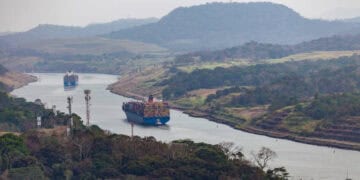PANAMA CITY — The Panama Canal, a key conduit for global trade, is undergoing a significant decrease in ship crossings, down by 36%, due to a severe drought that began last year.
Authorities in Panama announced the additional cuts on Wednesday, predicting a more substantial economic impact than initially expected. Canal administrators estimate that the lower water levels could result in financial losses ranging from $500 million to $700 million in 2024, a sharp increase from the earlier projection of $200 million.
This drought, considered one of the most severe in the nation’s history, has led to considerable disruptions along the 50-mile maritime passage. The reduction in canal traffic has caused a backlog of ships, leading to uncertainties about the canal’s dependability for international shipping and concerns regarding its implications for global trade.
Ricaurte Vasquez, the Panama Canal Administrator, announced the decision to reduce daily ship crossings to 24, a decrease from the usual 38 crossings per day. This reduction follows a gradual decrease implemented last year. Addressing the situation, Vasquez stated, “It’s vital that the country sends a message that we’re going to take this on and find a solution to this water problem.”
In the first quarter of the fiscal year, the canal experienced a 20% drop in cargo volume and 791 fewer ships compared to the same period in the previous year. Vasquez referred to this as a “significant reduction” for Panama. However, he also noted improvements in water management and an increase in rainfall in November, which have allowed for maintaining sufficient water levels to accommodate 24 ship crossings daily until the end of April, which marks the beginning of the next rainy season.
The canal’s authorities have linked the drought to the El Niño weather pattern and climate change. They have emphasized the urgency for Panama to identify new water sources to support the canal’s operations and the country’s needs. The same lakes that supply water to the canal are also a crucial water source for over 50% of Panama’s population, exceeding 4 million people. Vasquez emphasized, “The water problem is a national problem, not just of the Canal. We have to address this issue across the entire country.”
Explore the newest supply chain news at The Supply Chain Report. Visit ADAMftd.com for free international trade tools.
#PanamaCanal #GlobalTrade #DroughtImpact #ShippingChallenges #ClimateChange #ElNino #WaterManagement #EconomicImpact #Panama #InternationalShipping #TradeDisruptions #Logistics #SupplyChain

















